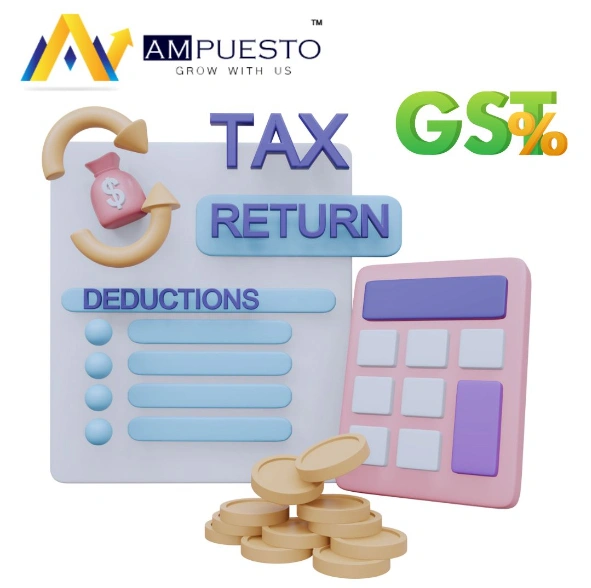What we’ll talk about in this blog:
- Overview of GST Returns
- Types of GST
- Types of GST Returns, Deadlines, and Penalties under the GST Act India
- Strategies for Simplifying Compliance
Overview of GST Returns
It is a comprehensive indirect tax in India that has taken the place of numerous other indirect taxes imposed by the federal and state governments. On July 1, 2017, GST became effective with the goals of streamlining the tax system, removing cascading effects, encouraging ease of doing business, and establishing a unified and transparent tax system.
Every step of the supply chain, from the manufacturer to the final consumer, is subject to the GST tax on the sale of goods and services. Because it is a destination-based tax, it is assessed at the point of consumption rather than the point of production.
Depending on their nature, it has divided commodities and services into different tax brackets, such as 0%, 5%, 12%, 18%, and 28%.
A technique known as a “reverse charge” in the GST system transfers tax responsibility from the supplier to the buyer of goods or services. Simply put, the recipient is in charge of reporting and paying the tax directly to the tax authorities rather than the provider collecting and remitting it. When a supplier is an unregistered person or when particular items or services are covered by the reverse charge mechanism as announced by the government, this approach is often used in those specific cases.
Types of GST
- CGST: CGST Stands for Central GST. This applies to supplies within the state. Tax collection will be shared with the Central government.
- SGST: SGST Stands for State GST. This applies to supplies within the state. Tax collection will be shared with the State government.
- IGST: CGST Stands for Integrated GST. This applies to interstate and import transactions. Tax collection will be shared with the Central & State governments.
Types of GST Returns, Deadlines, and Penalties under the GST Act, India
Under the Goods and Services Tax (GST) Act in India, there are specific dates for GST returns filing that must be met to avoid penalties. The following crucial dates and penalties are outlined in the GST Act in India:
GSTR-1: This return captures details of outward supplies made by the taxpayer.
- Due date: The GSTR-1 filing deadline varies depending on the taxpayer’s turnover:
a) Quarterly Filers: The due date is the 13th of the month following the end of the quarter.
b) Monthly Filers: The due date is the 11th of the next month.
- Late Filing Penalty: A late fine of Rs. 200 per day (Rs. 100 under CGST and Rs. 100 under SGST) is applied if GSTR-1 is not filed by the deadline. The highest late fee is 5,000 rupees.
GSTR-3B: This summary return gives a quick overview of the taxpayer’s tax liability.
- Due date: The 20th of the next month is the deadline for submitting GSTR-3B.
- Late Filing Penalty: A late fee of Rs. 50 per day (Rs. 25 under CGST and Rs. 25 under SGST) is imposed if GSTR-3B is not filed by the deadline. Rs. 5,000 is the maximum late fee.
GSTR-9: Registered taxpayers must submit this annual return each year.
- Due date: The GSTR-9 filing deadline is December 31st of the next fiscal year.
- Late Filing Penalty: According to the existing GST regulations, there is no provision for a late fine if GSTR-9 is not submitted by the deadline.
GSTR-9C: This is the yearly return and reconciliation statement that must be presented along with audited financial statements.
- Due date: It must be submitted by taxpayers whose combined annual revenue exceeds Rs. 2 crores.
- Late Filing Penalty: A late fee of Rs. 200 per day (Rs. 100 under CGST and Rs. 100 under SGST) is applied if GSTR-9C is not filed by the deadline. The highest late fee is limited to 0.25 percent of the taxpayer’s annual revenue in the relevant state or union territory.
Strategies for Simplifying Compliance
For businesses, complying with Goods and Services Tax (GST) laws can be difficult and time-consuming. However, firms can streamline their compliance procedure and guarantee smooth operations by putting some techniques into practice. Here are a few practical tips for streamlining GST compliance:
- Data Conversion Frequently: To ensure proper GST return filing, purchase, and sales data must be timely reconciled with that of suppliers and customers. This method assists in finding discrepancies, fixing mistakes, and preventing any discrepancies between the buyer’s and seller’s records.
- Automation and Accounting Software: The GST return process can be streamlined by using automated accounting software. These software programs may produce invoices, reconcile data, calculate taxes automatically, and give a thorough overview of the tax condition of the company.
- Calendar and Reminders for Compliance: Businesses can stay organized and guarantee timely filing by keeping a compliance calendar that lists the GST return filing due dates. Deadlines can be met more easily by using digital tools or setting up reminders.
- Training and Education of Employees: It is crucial to spend money on employee education and training for the GST compliance process or the GST return process. This guarantees that they are well aware of GST rules, revisions, and best practices. Businesses may decrease errors, increase efficiency, and lower the risk of non-compliance by improving their expertise. Various GST-related topics, such as return filing, input tax credit, required invoicing, and record-keeping, can be covered during training sessions. To keep staff members abreast of any changes to the GST framework, regular updates and refresher training should be offered.
- The assistance of an Expert: Getting expert advice from tax specialists or GST practitioners might offer helpful direction and support. These experts can assist firms in navigating the difficulties of compliance since they keep up with the most recent GST legislation. With the help of various web browsers, we can easily find experts online for GST return filing.
- Input Tax Credit Reconciliation Done Quickly: The claimed input tax credit must be compared to the information included in GSTR-2A or GSTR-2B. Any errors should be quickly fixed to prevent future compliance problems or credit loss.









